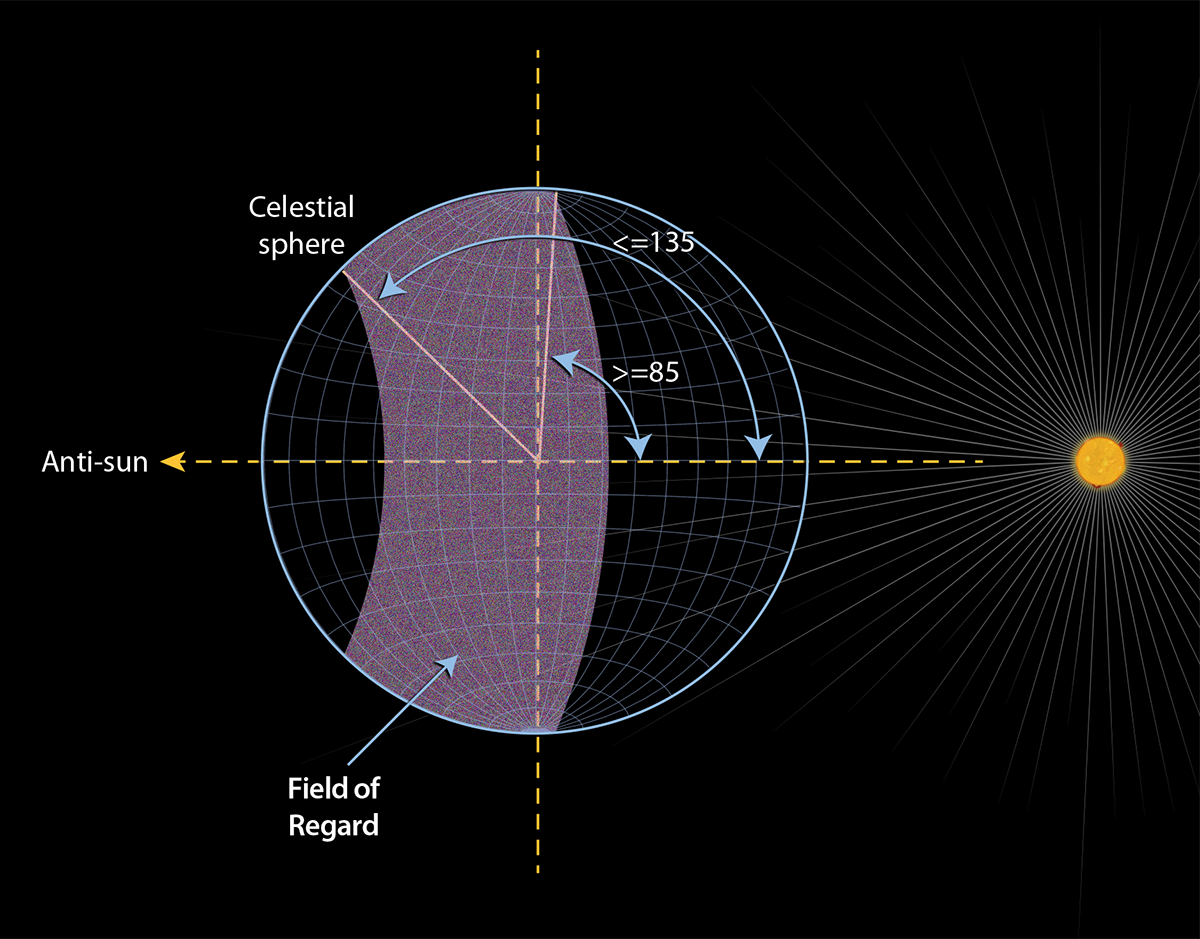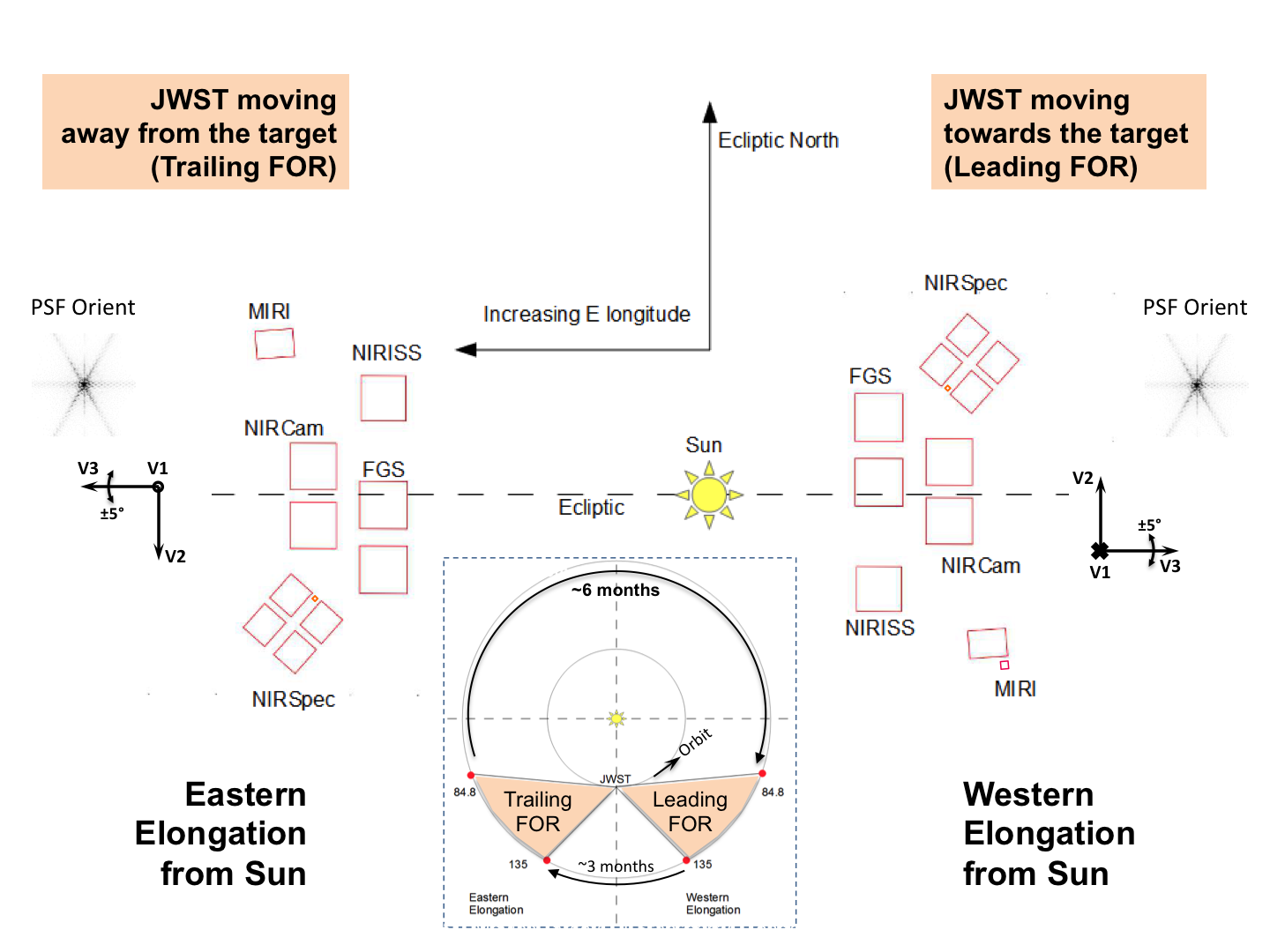Moving Target Field of Regard
The JWST field of regard will constrain the time of year a target can be observed. Because Solar System targets and the observatory are moving with respect to each other, the duration of the visibility windows could differ significantly from the standard durations.
On this page
Field of regard
See also: JWST Observatory Coordinate System and Field of Regard
The JWST field of regard (FOR) is the region of the sky where scientific observations can be conducted safely at a given time. The FOR is defined by the allowed range of boresight pointing angles for the observatory relative to the sun line, which must remain in the range 85° to 135° at all times to keep the telescope behind the sun shield. Thus, the FOR is a large torus on the sky that moves roughly 1° per day in ecliptic longitude, following the telescope in its path around the sun. Over time, this annulus sweeps over the entire celestial sphere. As a result of the FOR, JWST can observe about 39% of the full sky on any given day and can access 100% of the sky over 6 months. Figure 1 shows a schematic of the FOR.
Beginning in late 2022, NASA has imposed a micrometeoroid avoidance zone to minimize potential impacts from space debris coming from the direction of orbital motion. This zone overlaps a significant portion of the orbital leading side of the FOR torus. Observations in this overlap region with the FOR are not disallowed, but must be minimized for the long term safety of the observatory. Starting with Cycle 2, APT contains warnings and errors related to proposed observations that require observations in this restricted region.
See JWST Observatory Coordinate System and Field of Regard for a more detailed look at the field of regard (FOR) and observatory pointing constraints.
Constraints on moving targets
The constraints on elongation angle define the time of year a target can be observed. The JWST field of regard can be thought of as a hemisphere with a hole in it. The hole is due to the need to avoid observing at or near the anti-solar point. This shape results in 2 observing windows each year for objects along the ecliptic, each ~50 days long. Again, due to the shape of the field of regard, the time between the end of the first window and the beginning of the second is ~90 days. The end of the second window is followed by ~170 days until the first window opens again.
These numbers are rough estimates for fixed targets and slow-moving objects near the ecliptic; actual window lengths and spacings depend on the distance from the ecliptic and the magnitude of the apparent motion. Generally, objects further from the ecliptic will have larger observing windows, and the slower the apparent motion of an object, the larger its observing window. We recommend that proposers determine the observing windows for their objects using JPL Horizons (option 23, Sun-Observer-Target ELONG angle, in the Table Settings page can be used to specify a range of solar elongation angles).
The following Solar System bodies can never be observed by JWST: the Sun, Mercury, Venus, Earth, and the Moon. These constraints also mean that Mars is observable only every other year.
Instrument FOV orientations
See also:
JWST Field of View; JWST Instrument Ideal Coordinate Systems; JWST Position Angles, Ranges, and Offsets
To evaluate the allowable position angles for the science instruments when observing moving targets, use the Moving Target Visibility Tool (MTVT).
The Aladin feature in APT does not present accurate orientations for the instrument FOVs; this is the case for observations of both fixed and moving targets. The default orientation in Aladin has the V3 direction parallel to equatorial north, which is never valid for observations of targets near the ecliptic. See Tutorial on Visualizing Dithers of a Solar System Observation in APT for a workaround.
Click on the figure for a larger view.
Orientation of the JWST focal plane and instrument FOVs for observations in each section of the field of regard. The orientations shown above are the only 2 options for observations of objects along the ecliptic.

